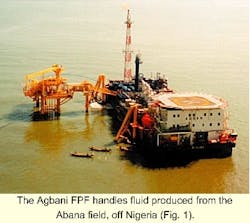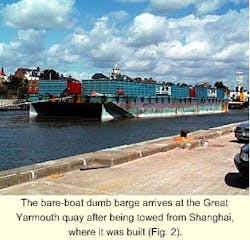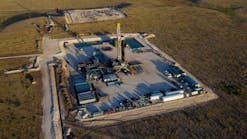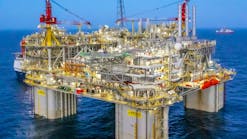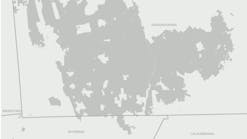Production facilities for the Abana field, offshore Nigeria, required conversion of a 90 m bulk-carrier barge to a floating production facility (FPF). The work, done on a fast track, required only 20 weeks.
The project achieved the target of first oil within 12 months of contract award and was significantly within the mutually agreed budget.
The Agbani FPF, installed off Nigeria in Block OPL230, handles production from the Abana field, operated by Moni Pulo Ltd. and technical partner Brass Exploration. The field lies at the mouth of the Calabar river, near the Cameroon border.
The Agbani FPF handles fluid produced from the Abana field, off Nigeria (Fig. 1).
The FPF is moored alongside the Abana East wellhead jacket that also routes incoming flowlines from the Abana West structure, 3.6 km away (Fig. 1).
Production concept
Brass Exploration Ltd. (then a wholly owned subsidiary of Western Atlas E&P) approached the Expro Group in December 1997 to discuss potential field-development options for the Abana field. Options included:
- A tanker-mounted production facility (FPSO) to be spread moored at a suitable location away from the wellhead clusters and flowlines. The FPSO would have to accommodate shuttle tankers for exporting the production.
- A shallow-water, moored-barge production system at the wellhead clusters with export to an offload point, such as a pipeline end manifold (PLEM) or other local offload facility.
Brass opted to proceed with the barge-mounted production facility for such reasons as safety of repeated off loading operations in shallow waters, operational and conversion costs, schedule, local support infrastructure, and local contract requirements from the Nigerian National Petroleum Corp. (NNPC).
One option added to the design included possible future gas compression. (An accompanying box lists the barge's specifications.)
Contract strategy
Expro was awarded the contract in March 1998. The contract included the FPF procurement, installation, commissioning, and operation. Prior to this, the negotiations involved the development of an innovative contract allowing Expro to have the flexibility and incentive to manage the project to meet the client's cost estimate and schedule targets.
The scope broadly comprised two phases, as follows:
1. Procuring a newly constructed dumb barge and converting it to moored FPF. Expro supplied the barge and all equipment to Brass on a reimbursable basis except for the process equipment which is owned by Expro and leased to Brass. The installed equipment included the mooring system and all topsides facilities, other than the process equipment.
Expro carried out the procurement and conversion phases against mutually agreed target costs and schedule. Expro received a project-management fee, based on the target cost. Against the project-management fee, a bonus or penalty payment structure was negotiated directly related to Expro performance on the target reimbursable cost and schedule.
2. Operating and maintaining the FPF including the wellhead structures. This work was also on an incentive basis.
Brass and Expro's common commercial objective was to deliver the Agbani for the least cost, in the least time, and to maximize revenues from continued oil production while maintaining strict export and discharge targets.
Installation of the main oil processing and water-injection facilities was included as part of the services contract, within the second phase of the project. This contract includes operation of the entire FPF facility, and wellhead platforms, including management of all associated third-party services.
As part of the services contract, purchase of all consumables for supporting the operation are on a transparent "open book" reimbursable basis, on behalf of Brass.
The scope of work awarded to Expro included the following:
- Procurement, marine conversion, and classification of the barge with Lloyds Register.
- Design, specification, and procurement of all systems such as process, power generation, accommodation, SOLAS (safety of life at sea), etc.
- Design, procurement, and installation of the mooring system.
- Towing the barge to Nigeria.
- Installation of the barge on location.
- System commissioning.
- Operation and maintenance for an initial 3-year period.
- Detailed design of all systems to incorporate a future gas-compression plant.
The Abana East and West jackets, and interconnecting and export flowlines were designed, constructed, and installed by others.
Target schedule
The target schedule included mutually agreed on milestone dates to allow unimpeded access to the wellhead and pipeline construction work, which occurred at the same time. The key to the project was to use common Brass and Expro contractors whenever possible.
This minimized overall project construction and installation costs, interface management and site engineering requirements, and was particularly important for the barge mooring system.
The schedule included:
- Engineering design phase complete-Apr. 2, 1998.
- Hazard and operability (HAZOP) survey-Mar. 23-25, 1998.
- Commence equipment procurement-Mar. 6, 1998.
- Fabrication and assembly complete-Oct. 15, 1998.
- Equipment installation complete-Nov. 19, 1998.
- Complete conversion phase-Dec. 30, 1998.
- Commence mobilization-Dec. 31, 1998.
- Complete mobilization phase-Feb. 3, 1999.
- Complete installation and commissioning phase-Mar. 1, 1999.
- Commence operations phase-Mar. 2, 1999.
Project organization
The project's success required a team of engineers capable of working closely together on a number of different packages. Management of the interfaces was key to ensuring that the schedule for the construction, installation, commissioning, and start-up phases would be reflective of the milestone dates.
The project also required the formation of a strong trust-based relationship with key contractors capable of working within the project ethos.
The same engineering team was involved from design to commissioning. Each team's goal was to design, procure, deliver, and commission components and packages that would ultimately form the Agbani FPF. The project manager ensured that the deliverables continued to be within budget, schedule, and specification.
Noble Denton Ltd., New Orleans, provided the marine engineers responsible for the mooring system design, transportation analysis, stability analysis, and superintendency services during installation.
One key factor to the project's success was the small, experienced, multiskilled, and flexible project team. This allowed quick reactive planning in any adverse situation. The flexible approach ensured that at all times the team could change the engineering course of the project. This generated cost savings, engineering efficiencies, and optimum project scheduling.
Three key contractors were identified to provide services for the marine and topside construction services, electrical and instrumentation, and structural steelwork construction. Each contractor was given a "cradle to grave" challenge encompassing all areas of the construction work required during the conversion period.
Barge conversion
The following were key to ensuring that the work was within the contract:
- A thorough "all avenues explored" design basis prior to the start of the conversion phase.
- Awareness of the interfaces with Brass and Expro subcontractors that established clear lines of communication.
- Development of a health and safety plan with the integration of the safety management key participants.
Immediately following the award of contract, a kick-off meeting nominated representatives at various project levels and by discipline, to ensure that clear lines of communication existed.
The meeting also determined the distribution of information, a schedule of deliverables from the different parties, and a program of meetings to be held during the preparatory phase. This enabled people to plan their work schedules and set project milestones.
The overall project schedule became an important control document. It set out key dates for the issue and receipt of information by the various parties, decision points, contract deliverables, and notice periods.
Subject to prior agreement with Brass, Expro placed contracts for the barge, various key subcontractors, and key long-lead items.
Expro awarded subcontracts within a short-time period, achieving the required "on the quay" date because of relationships established during previous contracts and tendering, specifications developed during the tender and FEED stages of the contract, and the application of standard terms and conditions.
The bare-boat dumb barge arrives at the Great Yarmouth quay after being towed from Shanghai, where it was built (Fig. 2).
The conversion work was performed in a quay at the Great Yarmouth Port, located near Expro's Southern UK base and an approved fabrication facility (Fig. 2). All installation work was planned to be carried out by contractors with a network of local support services.
Great Yarmouth was also the location of Expro Africa's FSU operational support base; hence, the operations personnel chosen for the project were involved in installation and training during hook-up.
To achieve the conversion schedule, it was important to have full control over the conversion site. Therefore, a freehold quay rather than a shipyard allowed Expro to mobilize the services required for the duration of the conversion without the requirement to use shipyard services and labor.
Prior to contract award, Expro identified a barge suitable for the FPF. Unfortunately, this barge was unavailable, but Expro located another in a Chinese shipyard. This vessel was deemed suitable and in the following 2 weeks, the final construction was completed, with the addition of towing attachments. From Shanghai, the barge was towed via Singapore through the Suez Canal to Great Yarmouth.
For the mooring system, Noble Denton Ltd. (NDE) proposed either an eight-legged catenary mooring or a piled-dolphin arrangement.
Spread mooring was unsuitable because of the proximity to the Abana East wellhead jacket and the space reserved for a workover rig. This mooring was also difficult due to the shallow water further exaggerated by more than 18 m of overlying soft silty clay. The dolphin mooring, therefore, was selected as the most suitable.
NDE proposed two fixed-jacket structures (dolphins) with barge guide frames supported by the dolphins that would moor the barge in a fixed location but still allow the barge to pitch, heave, and roll under changing water conditions. The sway, surge, and yaw motions were restricted through attachment to the dolphins.
The dolphins were fabricated in Louisiana at the same construction site as the Abana wellhead structures. This allowed the dolphins to be transported with the other Abana infrastructure and installed prior to the FPF arrival in Nigeria.
The construction included the barge's main process facilities being subjected to a mock hook-up prior to installation to verify interface, instrumentation, and control system compatibility. Precommissioning checks were carried out on all process utilities and emergency systems.
Expro has developed the mock hock-up and precommissioning philosophy for all of its fast-track process facilities. The testing is particularly pertinent for facilities for remote locations with limited infrastructure. Systematic testing of each installed package prior to mobilization greatly reduces the potential costs and lost time during project commissioning.
A technical review, during these tests, identified improvements that could be made.
A prejob risk assessment meeting, attended by representatives from operations and technical departments and the client, familiarized the teams with the equipment and made improvements to the safety plan and operating procedures.
Facilities fabrication
The barge conversion required coordination of packaged units, arranged to integrate as preassembled units (PAUs). This approach ensured that the package interfaces were completed in the most expeditious manner while mitigating the opportunity for delay and associated problems traditionally associated with multivendor procurement.
The scope for each individual PAU included the main equipment complete with all control and instrumentation accessories, sourced with a view to optimizing spares inventories.
Power-generation consisted of refurbished and tested gas turbines. These units minimized both costs and more importantly the long-lead times associated with new units.
This order was placed at the early stages of the project with a view to receiving the unit on the barge with time to complete and fully test the barge's electrical distribution system prior to the arrival of the main process units.
Water handling included several PAUs that were provided by short-listed suppliers with demonstrated expertise in fast-track fabrication. Each PAU was designed so that the package interfaces were minimized and full hook-up and testing conducted prior to arrival in the field. The units included equipment for a future retrofit of additional water-treatment facilities.
The custom-built accommodation module was A60 fire rated where required and approved for use on the installation. All facilities were procured allowing sufficient time for shipping, installation, and precommissioning aboard the barge prior to mobilization.
During the conversion period, a dry tow was selected as the safest method of transporting the FPF to the Abana location. The dry tow allowed access to the vessel hull, essential for anode installation.
Sacrificial anodes were installed on the hull, and a finish hull coating was applied after the FPF was loaded on the transporting vessel in The Netherlands.
Fig. 3 shows the barge being towed to the transportation barge loading site.
Project control
The project manager's responsibilities included planning and coordinating all engineering activities, defining the work scope, and completing and approving the work within the deadlines and budget.
The project manager nominated a team of project engineers responsible for expediting the various discipline specialties to ensure that the engineering was completed to the correct specifications and standards.
The engineers also coordinated the mobilization of the marine, accommodation, and process equipment, and the preparation of the interface documents, and installation and operating procedures.
The engineers all worked with the production-engineering department in Reading. Work in Reading included design of deck layout and process facilities, placement of equipment orders and service contracts, and preparation of interface and installation drawings and specifications.
One initial priority involved the finalizing of the process requirements, in consultation with Brass, and the configuration of the facilities on the barge, so that the risk assessment and HAZID identification exercise could take place quickly. This would ensure that any additional requirements or modifications raised at the early stage could be incorporated without adversely affecting the overall schedule.
The project engineers, in addition to their own experience, called on the experience of other engineers and operating personnel in the contractor's group who have been involved in previous production facility projects.
Expro reported to Brass through regularly scheduled meetings, held once a week. These meetings kept all parties informed on the various aspects of work where interfaces were critical. Other meeting agendas included the discussion and resolution of technical and financial documents, progress review, and project status.
Achievement
The conversion phase was completed in 20 weeks. While the barge was sailing from China, all orders were placed so that when it arrived at Great Yarmouth, all equipment would be at the quay ready to be installed directly onto the hull.
The complete FPF was mobilized and commissioned on location within 12 months of contract award and ahead of schedule. The entire project was under budget by 7%.
The Author
Raj Lekhy is a sales and marketing manager for surface and environmental systems of Expro Group, Aberdeen. He previously worked as a facilities engineer at Foster Wheeler Petroleum Development and managed the Agbani FPF project for Expro.
Lekhy has a mechanical engineering degree from Imperial College, London, and a MEng in petroleum engineering from Heriot Watt University.
